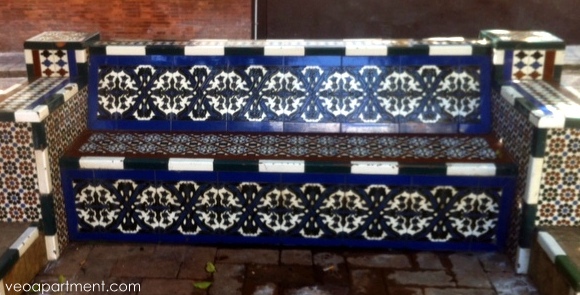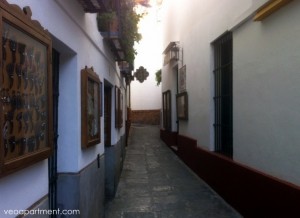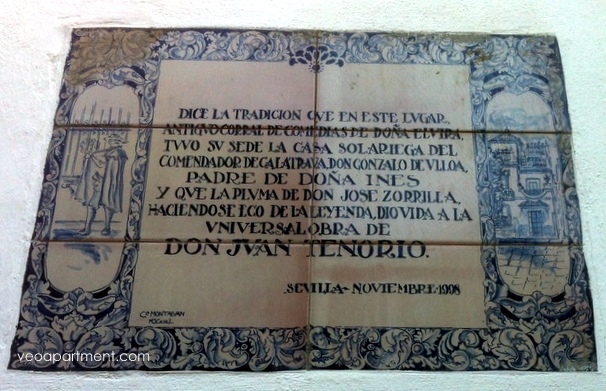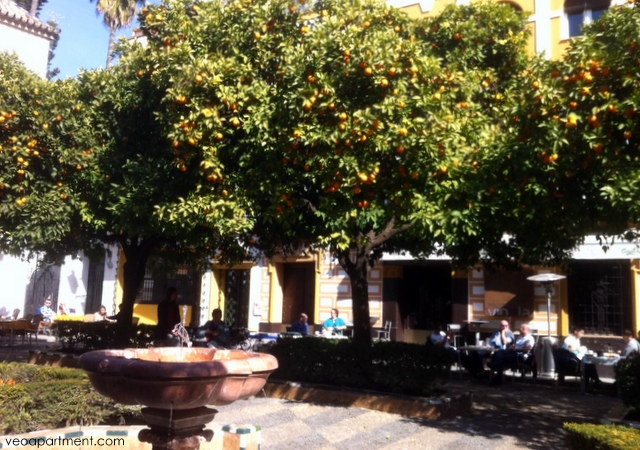Even in Seville, a city justly famous for its charming squares and other nooks, the Plaza de Doña Elvira in the Santa Cruz neighbourhood, even today still known as the old Jewish quarter, has to be one of the prettiest and most enchanting places you will ever see. It’s quite small, and is lined by orange trees and colourful tiled benches around an area of cobbled paving, flowerbeds, ornamental streetlights, and a central fountain. It’s reputed to be the birthplace (in what is now the Hotel Doña Elvira) of Dona Ines de Ulloa, the unrequited passion of Don Juan Tenorio, one of Seville’s most quintessential figures, immortalized first by Tirso de Molina, and later by Mozart in Don Giovanni.
 typical tiled bench
typical tiled bench
The approach to the Plaza along Rodrigo Caro street, around the walls of the Real Alcázar, is one of the most picturesque in the city, and anyone visiting the city should take the time to follow it. In Roman and Vizigothic times this area was outside the city walls, and was only enclosed by the Moors the ninth century. The pattern of narrow streets for which the Santa Cruz is famous, and which is typical of mediaeval Islamic cities, was created at this time, and the area of the modern square was probably occupied by a small block of houses.
 After Ferdinand III reconquered the city for the Christians in 1248, he allocated this neighbourhood to the Jews and enclosed it with high walls (the only remaining piece can be seen in Calle Fabiola). There was often tension between the Jewish and Christian communities, but in the years following the Black Death (1349) and the great earthquake of 1356, these tensions mounted until in 1391 the Christians went on a rampage through the Jewish quarter, looting, burning and killing. Most of the remaining Jews fled, or were scattered around the city.
After Ferdinand III reconquered the city for the Christians in 1248, he allocated this neighbourhood to the Jews and enclosed it with high walls (the only remaining piece can be seen in Calle Fabiola). There was often tension between the Jewish and Christian communities, but in the years following the Black Death (1349) and the great earthquake of 1356, these tensions mounted until in 1391 the Christians went on a rampage through the Jewish quarter, looting, burning and killing. Most of the remaining Jews fled, or were scattered around the city.
After the pogrom, Henry III gave the neighbourhood to Don Pedro Lopez de Ayala, and it was his daughter, Doña Elvira, who gave her name to the square. Their palace occupied part of the modern plaza, and had a small stable yard open to the street, forming a small square known as the Plaza de los Caballos. In the 16th century the yard was rented for the comedy theatre popular at the time (this was contemporary with Elizabethan theatre in England, with which it had much in common), and was known as the “Corral de Doña Elvira”.
Later, after the local authorities had banned the theatre performances, the yard was used as a warehouse, until in 1826, as part of a plan to revitalise the area, it was demolished, and the square enlarged to its present size (it probably acquired its current name at the same time), with the central fountain and benches. In 1924, as part of the preparations for the Spanish-American Exposition of 1929, the streetlights and flowerbeds were added, giving the square its modern appearance.
 tiled plaque on the Doña Elvira house
tiled plaque on the Doña Elvira house
We have a great selection of holiday apartments in this neighbourhood to give you the perfect base for exploring.
 Doña Elvira Square
Doña Elvira Square
Pingback: Seville | 7 Secret Corners of Seville | veoapartment